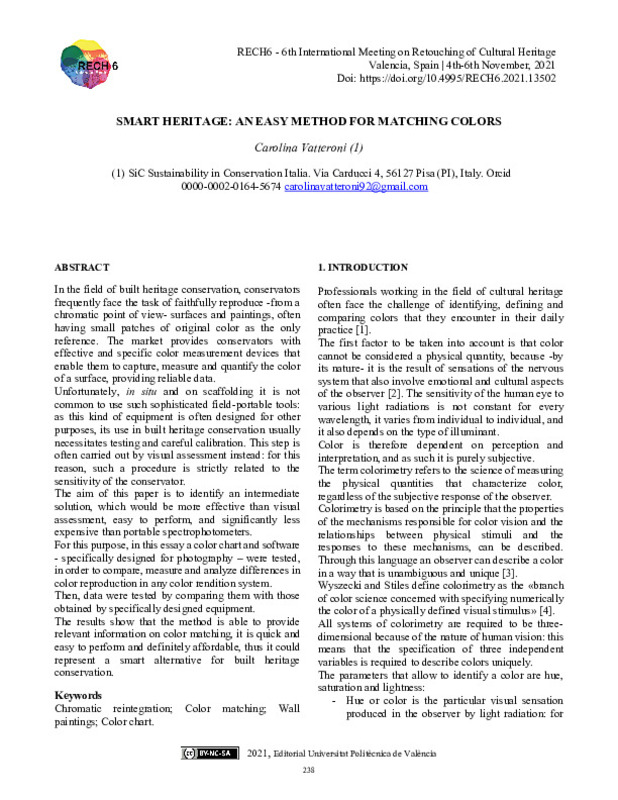|
Resumen:
|
[EN] Historic buildings and architectural surfaces are a significant part of the European heritage.In the field of preservation and conservation of historic facades – especially for those of buildings that are still in use ...[+]
[EN] Historic buildings and architectural surfaces are a significant part of the European heritage.In the field of preservation and conservation of historic facades – especially for those of buildings that are still in use - restorers frequently face the task of faithfully repurpose from a chromatic point of view surfaces and paintings, often having small patches of original color as the only reference.This step is often carried out by visual assessment by a restorer proficient in the field of colorant formulation and with in-depth knowledge of the behavior of colorants in a specific material: the process involves making a series of samples that are tested on the surface to be treated, in order to identify the most suitable.Nevertheless, such a procedure is strictly related to the sensitivity of the conservator.The series of samples produced can easily be subject to phenomena of observer metamerism and conditional match: in fact, it is possible that a set of samples that appear to match under a defined set of viewing conditions, such as light source or viewing angle, no longer match if those conditions change.Since restoration is first and foremost a science, the restorer is provided by the market with effective and specific color measurement devices that are able to capture, measure and quantify the color of a surface, providing reliable data: -in order of increasing sophistication- densitometers, colorimeters and spectrophotometers.Unfortunately, on a restoration site and scaffolding the restorer does not always have the opportunity to use such sophisticated field-portable: as such equipment is often designed for other purposes, its use in built heritage conservation usually necessitates testing and careful calibration on order to ensure accurate data.Compromises must be made: the aim of this paper is to identify an intermediate solution, which would be more effective than visual assessment, easy to perform, and significantly less expensive than portable spectrophotometers.How this will be achieved? The tool I tested for this purpose is X-Rite's Color Checker, a target specifically designed for photography and video production that is able to compare, measure and analyze differences in color reproduction in any color rendition system.I used the Color Checker target and software to compare original paintings with samples reproduced by visual assessment, in order to verify their spectral match, which means the two colors have the same color coordinates and appear identical regardless of illuminant or observer.Then, I tested my data by comparing them with those obtained by specifically designed equipment.The results show that this method is able to provide relevant information on color matching, it is quick and easy to perform and definitely affordable, and it could represent a smart alternative for built heritage conservation.
[-]
|









